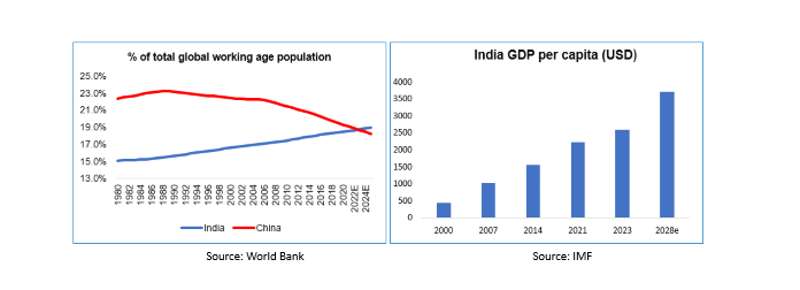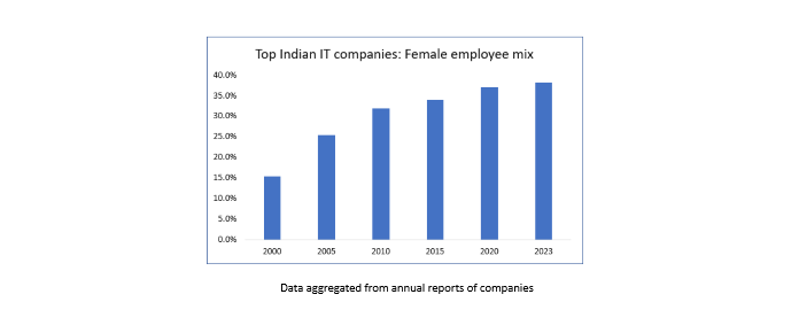With a population of 1,434,197,815, India surpassed China this year as the world’s most populous country. An apt moment to let Graeme Torre (Head of APG Asia-Pacific Real Estate) and Prashant Periwal (Senior Portfolio Manager Emerging Markets Equities) discuss the opportunities and challenges that come along with investing in India.
In summary
• As the world’s most populous country with a generally young population, India has its own unique proposition.
• For APG, the most interesting sectors of the Indian economy are financials, telecom, IT consultancy services, companies selling discretionary consumer items and certain real estate asset classes.
• While China has built an impressive network of infrastructure, India has not (yet) progressed anywhere near it.
• APG engages with large Indian manufacturers on ESG-norms and pushes them to compare their achievements with their Western peers and make improvements.
India is expected to become the third largest economy by the end of 2028, whereas at the beginning of the 21st century it was the thirteenth largest economy globally. Today, the size of the Indian economy is seven times what it was at the beginning of this century. Between 2021 and 2052, India will have the highest share of working-age population amongst major economies, meaning higher consumption, higher saving rates and higher tax revenue for the government, leading to a better fiscal situation and higher investments. What is more, the government has said it managed to reduce the poverty rate between 2005 and 2021 from 55 to 16 percent, although that figure might be exaggerated. Despite the impressive figures, there are still some hindrances to investing in India.
If you look into the future, where do the greatest opportunities lay for investors in India?
Torre: “India has its own unique proposition: apart from being the most populous country in the world, a sizable proportion of its population is also young. That young cohort will eventually leave school, get their first jobs, buy their first home, first car, first fridge, first insurance policy, etcetera. In other words, there is a huge source of future capital associated with that demographic segment. That’s a unique aspect of India. As far as investing in real estate is concerned, there are a number of sectors that correlate with that expected dynamic, such as retail, housing and logistics. After deciding upon a sector, for APG it comes down to the fine detail: where do we invest, which partner do we choose, what returns do we require?”
Periwal: “Beyond real estate, the most interesting sectors for us are financial services, primarily the large banks but in potential also insurance companies, followed by companies in discretionary sectors like automobiles, QSR, retailing and beverages. That upper end of the market was virtually non-existent in India until say ten years ago, but its growth has really picked up, which makes it very exciting for us. Those two sectors are among the most important if we look at the long term growth potential for India. Other large sectors where we are invested in are telecom, healthcare and IT consultancy services, the latter being a 150 billon dollar export industry; one of the largest forex earning sectors for India.”
Is the Indian economy balanced enough, or still too heavily dependent on the IT and consultancy sectors?
Periwal: “It’s a pretty balanced economy and a net import country, so not too dependent on the rest of the world for its economic growth, which has a potential growth of 6 percent plus annually. Other than IT services, India is seeing an influx of high paying jobs in a range of professional services like business consulting, human resources, legal, research and compliance services, as India is becoming a hub for Global Capability Centers set up by multinationals.
The per capita GDP has come from just about 450 dollar at the beginning of this decade, to over 2250 dollars now and is expected to reach 4000 dollar by 2030, leading to significant investment opportunities in India. The growth drivers for the Indian economy are predominantly domestic, a bit like what we see in the western world.
Demographic dividend is a work in progress, with working age population continuing to increase in India and the best is yet to come. India’s dependency ratio has come off by around 16 percentage points over the last 20 years to around 48 percent as of 2022. India’s aged dependency at 10 percent is much better when compared to some of the other major Emerging Markets like South Korea at 23, Taiwan at 22, China at 17 and Brazil at 14 percent. Somewhat of a concern might be that India’s investments in infrastructure are not that extensive, in comparison to those of China, for example.”

The state of infrastructure plays an important role when deciding to invest in certain sectors, like logistics for instance. To what extent does the current state of infrastructure in India prove a hindrance to investments?
Torre: “That is indeed a challenge for real estate sectors such as logistics, because there is a question mark over whether the road and railway systems are efficient enough to support modern logistic facilities, particularly for national distribution. In China, Australia and Europe, there are huge distribution centers on expressway junctions which makes distribution fast and efficient. You don’t see this in India very often, so there are some hindrances for the logistics sector if it is going to replicate the growth seen in other Asia economies. That is a big difference with China, where the government really took the lead on infrastructure building. Over the past twenty years, China has built road and highspeed train networks, harbors and airports throughout its eastern seaboard and way beyond. In the same period, India has yet to progress anywhere near this. Yet the development of infrastructure creates real estate value.”
Periwal: “To provide for sufficient infrastructure, you need huge amounts of land, but there are not enough land reforms. Also, returns on infrastructure projects in the past have been mediocre. Therefore, private investors were not too enthusiastic about it, so the construction of infrastructure has always been heavily dependent on government support. Yet I do think the situation in India for private investments in infrastructure will improve in the coming years.”
With 1.6 percent, India's share of global merchandise exports is rather low, especially in comparison to China. What is the reason behind that?
Periwal: “The Indian auto ancillary sector has been successful in establishing a large export base and we are beginning to see some traction in light manufacturing space. However, it is not a broad-based trend as yet. Another thing is that the participation of women in the manufacturing sector is low, probably less than 20 percent.
In comparison, in banking and IT services women make up for more than a third of the total staff. All the larger IT companies have sort of mini-universities, in which they offer training for young people who recently graduated from regular universities. These companies thus have invested in a labor pool, whereas manufacturing companies did not. That is another reason the manufacturing sector failed to pick up.”

According to the government, India’s economic growth has helped lift over 400 million people out of poverty between 2005 and 2021, reducing the poverty rate from 55 to 16 percent. How did the government succeed in that?
Periwal: “What happens is that the government sets a threshold, saying that anybody earning less than for instance 15 dollar a month is poor and the rest are not. A lot of academics say the government just established an artificially low poverty threshold, which makes it easy for a lot of people to cross that line, even though they still experience poverty in real life. But to be fair, prosperity among the Indian population is increasing and is evidenced by many sorts of data, such as the number of high value cars sold or per capita income of white collar workers. It’s hard to tell whether the poverty rate has indeed been reduced from 55 to 16 percent, but it’s safe to say that it’s definitely on the mend.”
How do you deal with the intricate bureaucracy and similar risks to investments?
Torre: “As far as real estate is concerned, we make sure we work with good partners, and understand the fine details of the market before we participate. So we do a lot of research, particularly on property ownership, relevant legal systems, the demand drivers for property, macroeconomics, and the due diligence track record of our potential partners. Every deal is custom made depending on the outcome of our due diligence. There is always the possibility of delays, for example in obtaining the necessary development approvals or in the delivery of materials. These delays exist in all markets but in India they can be exacerbated. Even so, these risks are priced in for us when we buy the land and make our first investment. In order to understand those risks, it is essential we use very capable local partners who can inform us about the fine details of the local market and have access to the leasing markets in order to find the right tenants in the right time. Currently, there is a huge demand from tenants in all sectors of the market. We just have to make sure we can access them for our projects.
We also review every investment periodically to ensure that the process, procedures and performance within each investment title are keeping up, or are at least capable of doing so, with our expectations. Of particular importance are expectations around governance, environmental, social and health and safety standards. ”
For APG, ESG criteria play an important role when deciding to invest in a company or not. What are currently the most important challenges for adopting ESG measures in real estate investments in India?
Torre: “There are still great steps forward to be made, but there is also almost universal recognition of the importance of ESG in each market where we invest. In particular as it relates to environmental performance standards for real estate. We always insist on international best practices in everything we build and wherever possible require that assets we own meet the ‘CRREM’ pathways, aligning their performance with the Paris Agreement. However, the environmental performance of buildings has many dependencies. Examples are greenhouse gas emissions and energy usage. These are impacted by the building regulations in each country and also by the nature of the power generation grid. Is it a fossil fuel grid, a nuclear grid, or a renewable energy grid? It’s usually a combination but in what proportion and what will it be in the future? India is still making its way in that respect. For instance, the building standards of office buildings we have created there are of very high quality, yet the power generation is in the hands of the government and a lot of it is fossil fuel powered.
China, on the other hand, is one of the largest renewable energy sources on the planet and they are making headway in providing their country with a reliable renewable energy grid. For instance, some local government policies in China have required us to put solar panels on the roofs of our logistics buildings. We were planning to do this anyway, of course. That is not yet always possible in India, but there is no reason why it should not progress the same way there.”
What are the main focus areas of APG in its engagement with listed companies?
Periwal: “The Indian market, even within the listed space, is characterized by high family holdings and low institutional oversight. In the past, this setup made engagements challenging. However, a strong regulatory push and the need to access global capital pools are leading to a change in mindset. We find that managements are increasingly more cognizant of sustainability issues and more receptive to our feedback and inputs.
Consequently, over the years the nature and substance of our engagements have evolved from a pure governance focus (rights of minority shareholders, board composition and independence, etcetera) to a much larger and varied gamut of environmental and social themes. In particular, we have lately been asking our investee companies to create accelerated decarbonization pathways, which are aligned with the goals of the Paris Agreement, and to reduce their fatality/injury rates. During these dialogues, we try and push companies to benchmark themselves against best practices and their peers in developed markets, who are usually ahead in terms of ESG performance and disclosures.”



